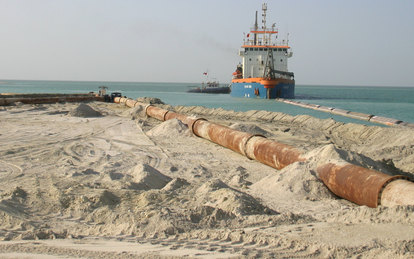Larger Trends in Beneficial Reuse of Dredged Sediment: What This Means for the Great Lakes

The gravel and silt dredged from the bottom of the Buffalo River used to be so contaminated that it had to be hauled off and buried at a special site. But now, that same dredged material is being beneficially reused as a part of the creation of new wildlife habitat on a river island between Buffalo and Niagara Falls. The Unity Island project is being carefully watched by scientists and engineers, as it is a first-of-its-kind project for the Great Lakes.
Because dredged sediment is now cleaner than it used to be – a result of the environmental standards enforced in recent decades – much of it is no longer required to be buried or stored in perpetuity. So a new opportunity exists for reusing what used to be thought of as unusable.
As I wrote in a recent article, “The Changing Currents for Beneficial Reuse of Dredged Sediment,” this practice is growing nationally and internationally. The U.S. Army Corps of Engineers (USACE) – which oversees many of the nation’s dredging projects – is now finding alternate uses for the dredged material: supplementing urban parks, restoring coastal wetlands, stabilizing eroding waterfront, and reestablishing fisheries in lakes and ponds.
This approach allows the USACE to advance its core mission providing vital public engineering services while also aiding the ecosystem. In the summer of 2019, crews will construct what’s called a “hemi-marsh” on Unity Island: a shoreline wetland of native pond vegetation that grows in shallow water.
“Now, clean sediment is coming down the watershed into our dredged channels and we can think creatively about how to utilize this material,” said Andrew Hannes, a senior ecologist at the USACE in a recent interview.
Similar Lake Erie projects are also now in the pipeline in Cleveland, Toledo, Ashtabula and Lorain, Ohio. The biggest challenge is finding ways to move the huge volume of sediment that gets trapped in ports, harbors and navigation channels without starving the downshore areas of the sediment they need to replenish their shorelines. For example, there's enough silt dredged from Toledo's harbor each year to fill 70,000 dump trucks. In Kenosha, Wisconsin, the Wisconsin DNR and USACE recently permitted the state’s second project involving beneficial reuse of clean sediment. This allowed 19,000 cubic yards of dredged sediment from Kenosha Harbor to be transported to a site 1.5 miles to the south, where currents and waves will move and disperse it along the Lake Michigan shoreline.
Another idea being considered is to build a series of wetlands near Toledo and in Sandusky Bay in Lake Erie’s western basin using dredged sediment. These wetlands could act as natural filters for water draining into the lake and could help reduce contaminants that result in harmful algae blooms. Hiking paths and recreational amenities can be built into these new wetland areas, providing recreational opportunities. Cleveland is also using some of the silt dredged from the Cuyahoga River for its own construction projects, and selling the rest to private companies for composting, construction, landscaping and road fill.
Finding new and creative uses for dredged sediment allows communities to put an end to unsustainable and potentially harmful disposal practices. In the past, Great Lakes cities with harbors that require regular dredging would have that sediment “placed” into the middle of the lakes because of the convenience and cheaper costs. Today, the U.S. Army Corp of Engineers, Great Lakes states, and individual communities have a greater awareness of the drawbacks to open-water disposal, along with a growing appreciation for how dredged material can be managed as a sustainable resource.
In other words, what was formerly a waste product has become a reusable commodity with value. Recognizing that value and identifying ways to maximize it is providing sound, practical and sustainable approaches to environmental restoration and to rebuilding coastal areas.